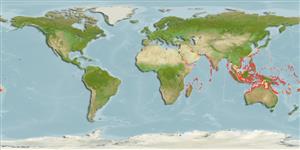Common names from other countries
>
Gobiiformes (Gobies) >
Gobiidae (Gobies) > Gobiinae
Etymology: Amblyeleotris: Greek, amblys = darkness + The name of a Nile fish, eleotris (Ref. 45335).
More on author: Bleeker.
Environment: milieu / climate zone / kisaran kedalaman / distribution range
Ekologi
laut berasosiasi dengan karang; kisaran kedalaman 5 - 35 m (Ref. 48637), usually 10 - 20 m (Ref. 27115). Tropical; 22°C - 28°C (Ref. 27115); 35°N - 23°S, 32°E - 174°W
Indo-West Pacific: Persian Gulf (Ref.80050) and Red Sea to Tonga, north to Japan and south to Australia.
Size / Weight / umur
Kematangan: Lm ? range ? - ? cm
Max length : 11.0 cm SL jantan/; (Ref. 48637)
deskripsi pendek
Kunci identifiaksi (pengenalan) | Morfologi | Morfometrik
Duri punggung (Keseluruhan (total)) : 7; duri punggung lunak (Keseluruhan (total)) : 12; Duri dubur: 1; Sirip dubur lunak: 12. Characterized by whitish body color; head and side with six brown to reddish bars and irregular brown blotches in pale spaces in between; four branched main body bars on lower side; red blotch on lower cheek just behind mouth; red or orange spots on head, dark-edged; separate pelvic fins, joined by low membrane at base of fins; without median predorsal scales or only few embedded scales just in front of first dorsal fin; longitudinal scale series 80-85; greatest depth of body 4.6-6.4 in SL; caudal fin longer than head, 2.8-3.4 in SL (Ref. 90102).
Body shape (shape guide): elongated; Cross section: circular.
Inhabits coastal to outer reef sand slopes to 35 meters depth (Ref. 48637); on sandy areas of lagoon and seaward reefs (Ref. 9710). Inhabits burrows with alpheid shrimps (Ref. 11441).
Life cycle and mating behavior
Kematangan | Reproduksi, perkembang biakan | Pemijahan | telur-telur | Fecundity | Larva
Myers, R.F., 1991. Micronesian reef fishes. Second Ed. Coral Graphics, Barrigada, Guam. 298 p. (Ref. 1602)
Status IUCN Red List (Ref. 130435: Version 2025-1)
ancaman kepada manusia
Harmless
penggunaan manusia
Perikanan: komersial; Akuarium: Komersial
Alat, peralatan
laporan khas
muat turun XML
Sumber internet
Estimates based on models
Preferred temperature (Acuan
123201): 25.2 - 29.1, mean 28 °C (based on 484 cells).
Phylogenetic diversity index (Acuan
82804): PD
50 = 0.5000 [Uniqueness, from 0.5 = low to 2.0 = high].
Bayesian length-weight: a=0.00724 (0.00339 - 0.01546), b=3.10 (2.92 - 3.28), in cm total length, based on LWR estimates for this (Sub)family-body shape (Ref.
93245).
Trophic level (Acuan
69278): 3.4 ±0.4 se; based on size and trophs of closest relatives
Daya lenting (Acuan
120179): Tinggi, Waktu penggandaan populasi minimum kurang dari 15 bulan (Preliminary K or Fecundity.).
Fishing Vulnerability (Ref.
59153): Low vulnerability (10 of 100).
🛈
Nutrients (Ref.
124155): Calcium = 122 [55, 228] mg/100g; Iron = 0.714 [0.369, 1.368] mg/100g; Protein = 17.9 [15.9, 19.6] %; Omega3 = 0.0936 [, ] g/100g; Selenium = 25.3 [12.0, 54.9] μg/100g; VitaminA = 132 [35, 453] μg/100g; Zinc = 1.92 [1.25, 2.84] mg/100g (wet weight);
